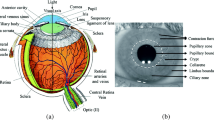Abstract
The traditional pupil positioning method is carried out under the assumption that the pupil boundary is a regular circle, and thus the rich texture features around the pupil boundary are eliminated, which directly affects the iris recognition accuracy. To solve this problem, this paper proposes an irregular pupil positioning method, finds the pupil boundary by preprocessing, then uses the least-squares method to accurately fit the pupil boundary. Finally, the algorithm is verified and analyzed by the CASIA database, and the traditional Hough transform method is used as a comparative experiment. The experimental results show that the proposed algorithm is not only suitable for irregular pupil boundaries (including noncircular and concave and convex areas), but also better in positioning time and positioning accuracy.
Access this chapter
Tax calculation will be finalised at checkout
Purchases are for personal use only
Similar content being viewed by others
References
Daugman, J.: How iris recognition works (Chap. 25). Essential Guide to Image Processing, pp. 715–739 (2004)
Zhu, L., Yuan, Y.: Non-ideal iris localization based on sum-checking and edge detection template. Appl. Res. Comput. 35(06), 1879–1882 (2018)
Li, Z.: An iris recognition algorithm based on coarse and fine location. In: Proceedings of 2017 IEEE 2nd International Conference on Big Data Analysis (ICBDA 2017). IEEE Bei**g Section, **’an Jiaotong-Liverpool University: IEEE Bei**g Section (Multinational Institute of Electrical and Electronics Engineers Bei**g Branch) (2017)
Kumar, V., Asati, A., Gupta, A.: Accurate iris localization using edge map generation and adaptive circular hough transform for less constrained iris images. Int. J. Electr. Comput. Eng. 6(4), 1637–1646 (2016)
Tisse, C., Martin, L., Torres, L., Robert, M.: Person identification technique using human iris recognition. In: Proceedings of ICVI’02, pp. 294–299 (2002)
Liu, S., Liu, Y., Zhu, X.: Iris location algorithm based on block search 2017 August 29. Comput. Eng. Appl. (2017)
Tian, K.: Ellipse fitting algorithm based on least squares (2008)
http://biometrics.idealtest.org/findTotalDbByMode.do?mode=Iris. Accessed 26 Nov 2019
Yannian, Wang, Langyue, Zhao, Huimin, Liu: An accurate method of iris localization. Foreign Electron. Meas. Technol. 36(11), 34–37 (2017)
Author information
Authors and Affiliations
Corresponding author
Editor information
Editors and Affiliations
Rights and permissions
Copyright information
© 2020 Springer Nature Singapore Pte Ltd.
About this paper
Cite this paper
Zhao, Y., Zhang, S., Lei, H., Ma, J., Wang, N. (2020). Research on an Irregular Pupil Positioning Method. In: Kountchev, R., Patnaik, S., Shi, J., Favorskaya, M. (eds) Advances in 3D Image and Graphics Representation, Analysis, Computing and Information Technology. Smart Innovation, Systems and Technologies, vol 180. Springer, Singapore. https://doi.org/10.1007/978-981-15-3867-4_21
Download citation
DOI: https://doi.org/10.1007/978-981-15-3867-4_21
Published:
Publisher Name: Springer, Singapore
Print ISBN: 978-981-15-3866-7
Online ISBN: 978-981-15-3867-4
eBook Packages: Intelligent Technologies and RoboticsIntelligent Technologies and Robotics (R0)




